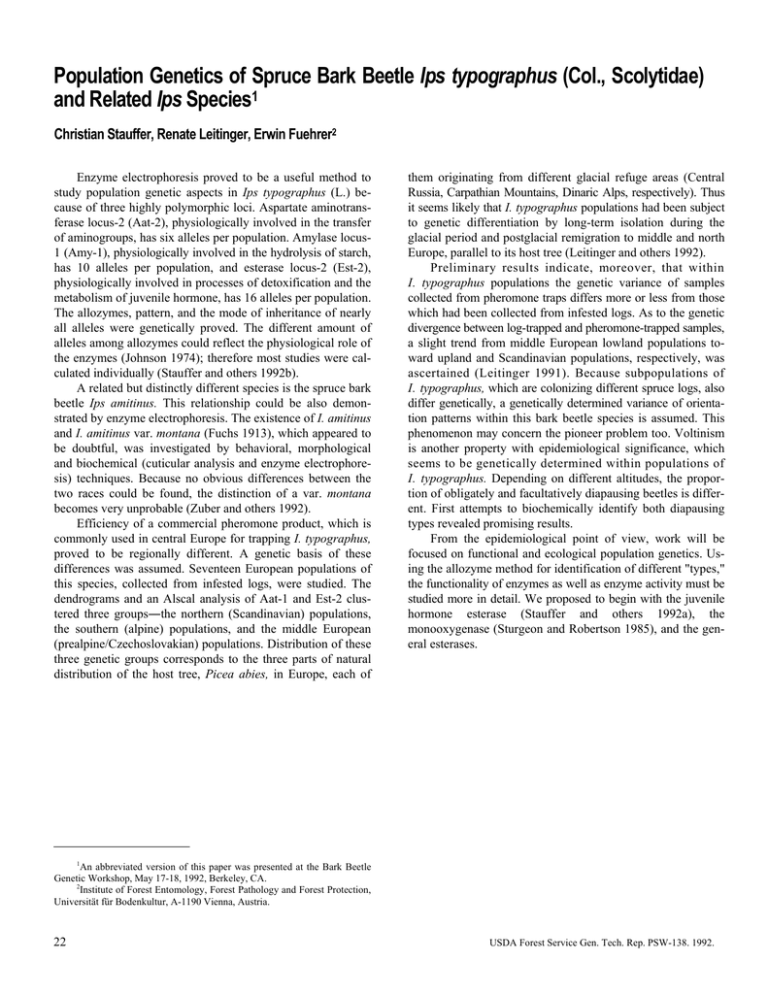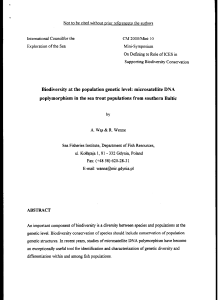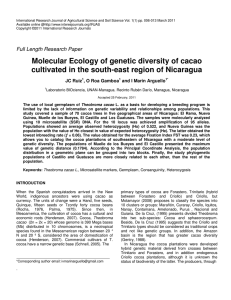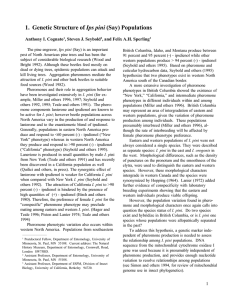Ips typographus Ips Christian Stauffer, Renate Leitinger, Erwin Fuehrer 1
advertisement

Population Genetics of Spruce Bark Beetle Ips typographus (Col., Scolytidae) and Related Ips Species1 Christian Stauffer, Renate Leitinger, Erwin Fuehrer2 Enzyme electrophoresis proved to be a useful method to study population genetic aspects in Ips typographus (L.) because of three highly polymorphic loci. Aspartate aminotransferase locus-2 (Aat-2), physiologically involved in the transfer of aminogroups, has six alleles per population. Amylase locus1 (Amy-1), physiologically involved in the hydrolysis of starch, has 10 alleles per population, and esterase locus-2 (Est-2), physiologically involved in processes of detoxification and the metabolism of juvenile hormone, has 16 alleles per population. The allozymes, pattern, and the mode of inheritance of nearly all alleles were genetically proved. The different amount of alleles among allozymes could reflect the physiological role of the enzymes (Johnson 1974); therefore most studies were calculated individually (Stauffer and others 1992b). A related but distinctly different species is the spruce bark beetle Ips amitinus. This relationship could be also demonstrated by enzyme electrophoresis. The existence of I. amitinus and I. amitinus var. montana (Fuchs 1913), which appeared to be doubtful, was investigated by behavioral, morphological and biochemical (cuticular analysis and enzyme electrophoresis) techniques. Because no obvious differences between the two races could be found, the distinction of a var. montana becomes very unprobable (Zuber and others 1992). Efficiency of a commercial pheromone product, which is commonly used in central Europe for trapping I. typographus, proved to be regionally different. A genetic basis of these differences was assumed. Seventeen European populations of this species, collected from infested logs, were studied. The dendrograms and an Alscal analysis of Aat-1 and Est-2 clustered three groups―the northern (Scandinavian) populations, the southern (alpine) populations, and the middle European (prealpine/Czechoslovakian) populations. Distribution of these three genetic groups corresponds to the three parts of natural distribution of the host tree, Picea abies, in Europe, each of them originating from different glacial refuge areas (Central Russia, Carpathian Mountains, Dinaric Alps, respectively). Thus it seems likely that I. typographus populations had been subject to genetic differentiation by long-term isolation during the glacial period and postglacial remigration to middle and north Europe, parallel to its host tree (Leitinger and others 1992). Preliminary results indicate, moreover, that within I. typographus populations the genetic variance of samples collected from pheromone traps differs more or less from those which had been collected from infested logs. As to the genetic divergence between log-trapped and pheromone-trapped samples, a slight trend from middle European lowland populations toward upland and Scandinavian populations, respectively, was ascertained (Leitinger 1991). Because subpopulations of I. typographus, which are colonizing different spruce logs, also differ genetically, a genetically determined variance of orientation patterns within this bark beetle species is assumed. This phenomenon may concern the pioneer problem too. Voltinism is another property with epidemiological significance, which seems to be genetically determined within populations of I. typographus. Depending on different altitudes, the proportion of obligately and facultatively diapausing beetles is different. First attempts to biochemically identify both diapausing types revealed promising results. From the epidemiological point of view, work will be focused on functional and ecological population genetics. Using the allozyme method for identification of different "types," the functionality of enzymes as well as enzyme activity must be studied more in detail. We proposed to begin with the juvenile hormone esterase (Stauffer and others 1992a), the monooxygenase (Sturgeon and Robertson 1985), and the general esterases. 1 An abbreviated version of this paper was presented at the Bark Beetle Genetic Workshop, May 17-18, 1992, Berkeley, CA. 2 Institute of Forest Entomology, Forest Pathology and Forest Protection, Universität für Bodenkultur, A-1190 Vienna, Austria. 22 USDA Forest Service Gen. Tech. Rep. PSW-138. 1992.










